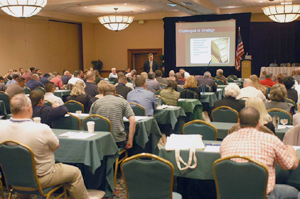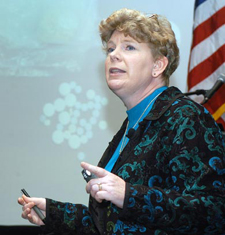
|
CONNECTIONS
|
IDAHO
ITD
HOME
IDAHO DMV
ITD
NEWS
HIGHWAY
SAFETY
IDAHO STATE
POLICE
TRAVEL SERVICES
STATE OF IDAHO
NATIONAL
AASHTO
AAMVA
AAA of IDAHO
FEDERAL HIGHWAYS
FEDERAL AVIATION
IDAHO STATE POLICE
NHTSA
NTSB
TRB
U.S. DOT
Idaho
Transportation
Department
Public Affairs Office
P.O. Box 7129
Boise, ID 83707
208.334.8005
Fax: 208.334.8563
Email

Safety Summit features MAMa founder,
injury prevention researchers
 It
wasn’t crash analysis pictures, statistics or even graphic photographs
of lives ravaged by methamphetamine use that silenced a room full of
highway safety professionals last week.
It
wasn’t crash analysis pictures, statistics or even graphic photographs
of lives ravaged by methamphetamine use that silenced a room full of
highway safety professionals last week.
It was a group of images showing neglected children burned or contaminated by caustic chemicals used in the drug’s production.
Dr. Mary Holley, author of “Crystal Meth: They Call it Ice” and executive director of Mothers Against Methamphetamines (MAMa), told a group of about 185 attendees that child endangerment is the fastest way for law enforcement to intervene in a “meth” environment. Meth users have problems with child abuse, she said.
Holley was one of several speakers featured at the 2007 Highway Safety Summit sponsored by ITD’s Office of Highway Operations and Safety April 11 in Boise.
Meth environments are as likely to be found on the nation’s highways as they are in towns and cities, according to Holley, but many first responders – like firemen and paramedics – are not trained for those environments. She acknowledged that while law enforcement officers are better trained they still encounter great risk.
 “Threats
of guns and booby traps exist wherever the drug is manufactured,”
Holley said. “Meth addicts are always armed.”
“Threats
of guns and booby traps exist wherever the drug is manufactured,”
Holley said. “Meth addicts are always armed.”
“Their cars are as bad as their living environments,” she said referring to the squalid and dangerous conditions often found in clandestine or “kitchen” meth labs. The labs have increasingly become mobile in order to escape detection.
Holley, a physician whose own addicted brother committed suicide in 2000, discussed the stages of addiction, the physical and psychological deterioration of a meth addict’s brain, and the difficulties of treating the addiction.
“Use it once and you will use it again,” she said. “It takes 12 to 18 months to recover from an addiction that can be achieved in one night.” She added that relapse rates were extremely high.
In addition to Idaho law enforcement professionals, this year’s summit was attended by representatives from AAA, Safe Kids of the Magic Valley, Wyoming Highway Patrol, Idaho Trauma Registry, Idaho Department of Education, Oregon Department of Transportation, Farmers Insurance, St. Luke’s Regional Medical Center and the Oregon State Police.
Prosecution efforts
Other morning sessions featured Idaho Traffic Safety Resource Prosecutor
Jared Olson, who discussed challenges to prosecuting impaired drivers;
a federal perspective on Idaho’s traffic safety situation offered
by John Moffat, regional administrator for the National Highway Traffic
Safety Administration (NHTSA); and a preview of the 2007 highway safety
mobilization by Mary Hunter, grant officer for OHOS.
Unrestrained facts
Max Sevareid concluded the morning by taking summit participants through
the potential impact of a primary enforcement seat belt law on health
care costs in Idaho.
An injury prevention liaison with the Harborview Injury Prevention Research Center (HIPRC) in Seattle, Sevareid said recent research shows that motor vehicle occupants who do not wear seat belts and are injured or killed in a crash cost taxpayers more money than the restrained occupants.
He said preventable motor vehicle crash costs to Idaho state budgets totals $9.1 million annually. The fine for not wearing a seat belt should be more than $340 in order to better offset costs to taxpayers.
And, according to Sevareid, these costs don’t include accident scene transport, work lost, rehabilitation, long-term complications, public assistance, impacts to families, costs to employers and higher insurance premiums.
Idaho currently has a secondary seat belt law that carries a $10 fine.
“Enforcement increases seat belt use,” Sevareid told the group. “In a recent multi-state study, every dollar increase in the seat belt fine showed some proportionate increase in seat belt use.”
Vehicle design and safety
Rob Kaufman, a crash investigator who also works for HIPRC, opened the
summit’s afternoon sessions. Kaufman’s emphasis is on vehicle
design and in particular how real people - not crash test dummies -
are injured during a motor vehicle crash.
 HIPRC
participates as a site in the Crash Injury Research and Engineering
Network (CIREN), sponsored by NHTSA and the automotive industry. Researchers
at each CIREN site share data and expertise to lead to a better understanding
of crash-injury mechanisms and the design of safer vehicles.
HIPRC
participates as a site in the Crash Injury Research and Engineering
Network (CIREN), sponsored by NHTSA and the automotive industry. Researchers
at each CIREN site share data and expertise to lead to a better understanding
of crash-injury mechanisms and the design of safer vehicles.
As part of a typical crash investigation, Kaufman inspects the scene and searches the wrecked vehicle for critical clues. He examines the occupant compartment where he notes restraint status, seat location and contact evidence – exactly what the occupant hit inside the vehicle during the crash.
Research that Kaufman and other investigators gather one day may lead to safer motor vehicles that are better equipped to manage the forces of a vehicle crash. For now, that research, combined with additional field training, helps law enforcement officers evaluate occupant injuries based on a visual assessment of vehicle damage.
Side impacts are serious and one of the most deadly crashes,
according to Kaufman.
“One foot of door panel movement into the body can cause a number
of serious injuries from the head to the pelvis, particularly if there
is a raised center console,” he said.
A solution to reducing the severity of side impacts might be to mount vehicle seats on a form of lateral track so that the seats are not so rigidly fixed.
Children who are seated in vehicles without booster seats are more likely to suffer severe head injuries because their head sits lower in the car and is more exposed to the metal of a car door.
Seat belt usage
Nationwide, seat belt use rates have climbed from a dismal 14 percent
in 1983 to the current level of 80 percent, according to Kaufman.
He said research shows that one out of six crash deaths could have been prevented if all vehicle occupants wore seat belts. “Restrained occupants can have a 22 to 25 percent increased risk of death when an unrestrained person is seated in a vehicle behind or next to them.”
 The
summit concluded with Idaho Seat Belt Coalition co-chairs Dave Carlson
and Lynette Sharp discussing the successes and setbacks in this year’s
push to secure a primary seat belt law in Idaho. They agreed that the
coalition should grow stronger and continue the effort.
The
summit concluded with Idaho Seat Belt Coalition co-chairs Dave Carlson
and Lynette Sharp discussing the successes and setbacks in this year’s
push to secure a primary seat belt law in Idaho. They agreed that the
coalition should grow stronger and continue the effort.
OHOS staffers Susan Mulkey and Greg Fredericksen talked about collecting and processing crash data. Sgt. Ted Piche of the Lewiston Police Department recounted a vehicle crash he survived because he was wearing a seat belt and concluded by reminding the assembled law enforcement officers why they enforce society’s laws.
- - - - -
Photos: Dr. Mary Holley, author of “Crystal Meth: They Call it Ice” and executive director of Mothers Against Methamphetamines (MAMa) (upper right) and crash investigator Rob Kaufman of the Harborview Injury Prevention Research Center in Seattle (middle left).
Published 4-20-07